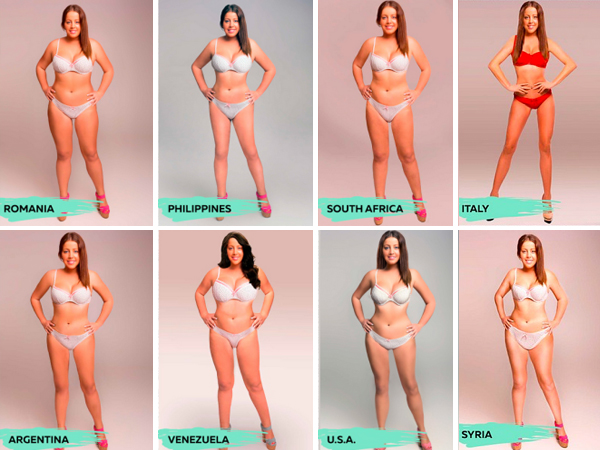What is the 'ideal' female body shape?
Fashion has long seen the female body as a malleable entity, something to be moulded according to the dictates of complex social codes or the fickle whims of the fashion industry.

By analysing the changing fashionable silhouette from the 18th Century to the present day, a new exhibition at the Fashion Institute of Technology in New York (FIT) argues that the fashionable body has always been a cultural construct and one that needs to be challenged if we are to reach a greater acceptance of body diversity.
There was a prevailing belief that women’s bodies were inherently weak and in need of support – Emma McClendonBeing ensconced in stays created a uniquely rigid carriage. By mastering an elegant gait whilst constrained in such an uncomfortable garment was a sign of breeding. “There was also a prevailing belief during the period that women’s bodies were inherently weak and in need of support,” says McClendon. These ideas were challenged by some of the leading writers and thinkers of the day, with the philosopher and writer Rousseau seeing stays as a particularly apt metaphor for the social institutions constraining the individual - but his views had little impact.
The return to a nipped-in waist, shown to its best advantage by the voluminous crinoline, in vogue from 1845 to 1870, drew attention to the upper body, which was considered “the most precious,” according to Denis Bruna, curator of the fashion department of the Musée des Arts Décoratifs in Paris. “In Western culture the lower parts of the body are not considered worthy, which is why women’s legs have been hidden for centuries under skirts and petticoats.”
Pressure to conform
The appearance of the bustle, which gave prominence to the rear, from 1870 onwards coincided with an era in which fashion was becoming progressively more democratised, as technical advances and the rise of the department store meant that different social classes were buying similar styles, thus creating a certain standardisation of the ideal silhouette and creating a pressure to conform among all social classes.
The early 20th Century saw the aesthetic dress movement, typified by elegant flowing gowns created by the department store Liberty, attempt to liberate women from the confines of the corset. It was a style favoured in artistic circles but considered eccentric by the general public, and even those who chose to adopt the fashion rarely wore it outside the confines of the home.
However much the fashion press wanted to ignore them there have always been stylish larger womenIt wasn’t until the flapper styles of the 1920s came into fashion that conventional corsetry began to lose favour. Although McClendon is at pains to point out that it is “a common misconception that women stopped wearing corsets and were suddenly ‘free.’” The new styles required a lithe androgynous body achieved by wearing a hip-slimming girdle, which although certainly more comfortable still created an artificial body shape.
Women for whom the look was impossible to achieve found other ways to be fashionable. The exhibition features a pair of purple-and-orange crepe pyjamas that have a 40-inch (101.6 cm) waist, proving that however much the fashion press wanted to ignore them there have always been stylish larger women.
Embracing diversity
During the 1940s broad shoulders and narrow hips were popularised by the film costume designer Gilbert Adrian and the silhouette dominated the decade, until Christian Dior dramatically broke away from it with his ‘New Look’, which emphasised a prominent bust and nipped-in waist and required up to 20m (65.62ft) of fabric. “He wanted to create dresses that were a response to the poverty of the war period,” says Bruna. This ultra-feminine aesthetic came to symbolise the 1950s.
Corsets and girdles may have fallen out of favour, but women faced a new set of constraints as increasing emphasis was put on diet and exercise throughout the 1970s and 80s in order to maintain the fit, toned body required for the fluid sensual designs of Halston or the body-conscious dresses of Thierry Mugler. Fashion magazines championed slender bodies with paradoxically large breasts in the 1980s, a look achievable to most only via surgery, and then the waifish extreme of Kate Moss in the 1990s.
The rise of social media has gradually begun to change the way people consume and engage with fashionAlthough a slender physique still dominated much of the fashion industry at the beginning of the 21 st Century, the rise of social media has gradually begun to change the way people consume and engage with fashion. Personal style blogs and platforms like Instagram and Twitter are opening up the industry to an ever-greater cross-section of people.
Christian Siriano includes plus-size models in his catwalk show and makes clothes up to size 26. When the actress Leslie Jones complained on Twitter that no label would dress her because of her size, Siriano said he would be proud to do so and created a stunning red gown.
“It is not our bodies that are wrong, it is the sizing system that is wrong,” she says. “Until we acknowledge the problems in the current system, we cannot begin to fix it.”




No comments